文章目录
- 1.移除链表元素
- 方法1:
- 方法2
- 2.合并两个有序链表
- 3.链表的中间节点
- 方法1
- 方法2
- 4.反转单链表
- 方法1
- 方法2
- 5.分割链表
- 6.链表中的倒数第k个节点
- 方法1:
- 方法2:
- 7.环形链表的约瑟夫问题
- 8.链表的回文结构
- 9.相交链表
- 方法1
- 方法2:
- 10.环形链表
- 11.环形链表Ⅱ
- 12.随机链表的复制

链表学习完以后,来做点相关题目吧
1.移除链表元素
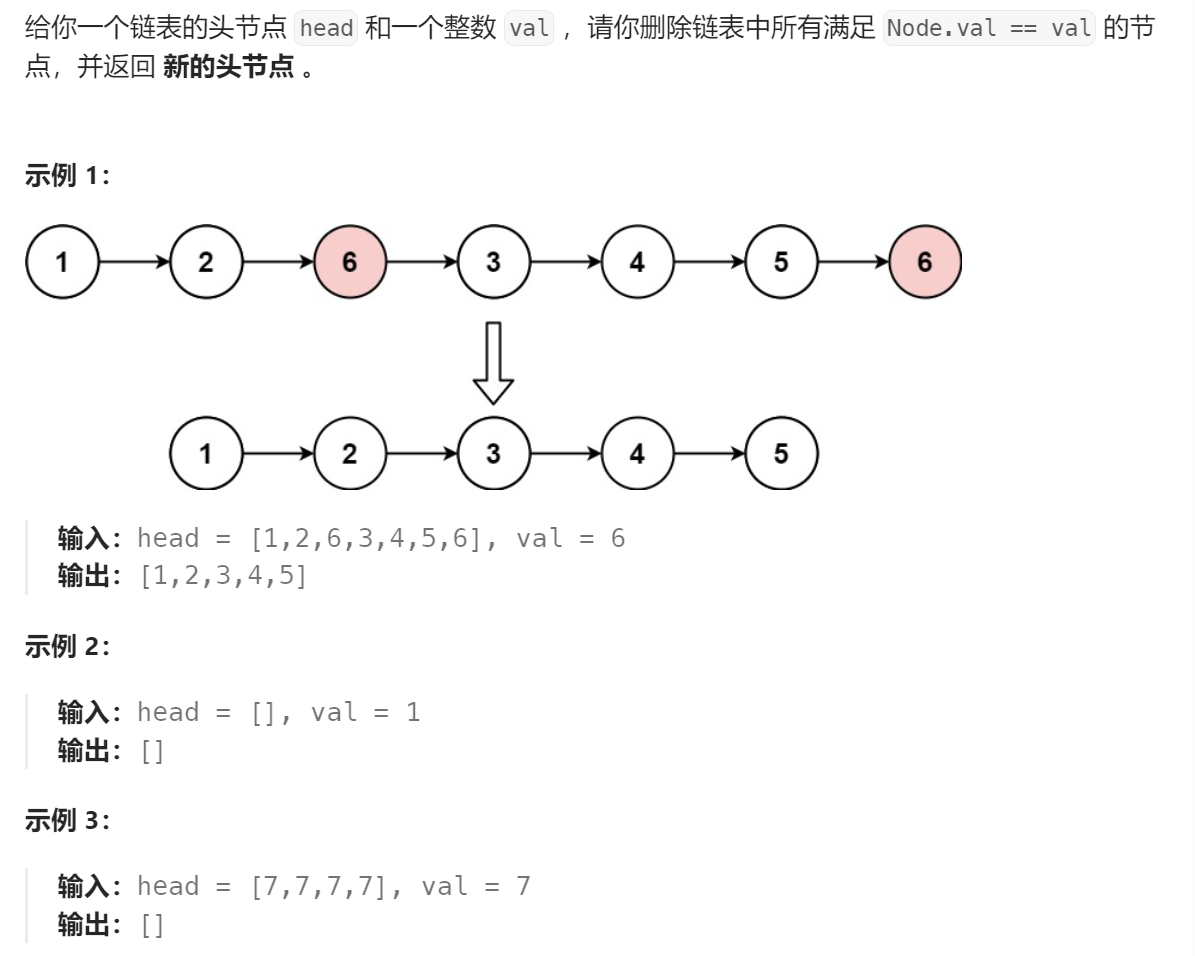
方法1:
在原链表的基础上直接删除指定元素
- 若当前节点是要删除的节点,则将其前驱节点指向当前节点的下一个节点
- 若当前节点不是要删除的节点,前驱节点指向当前节点,当前节点后移
- 特殊情况:
- 循环判断,若头节点是要删除的节点,则将头节点后移
- 头节点不为空
struct ListNode* removeElements(struct ListNode* head, int val) {struct ListNode* cur = head;struct ListNode* prev = head;//判断头节点while(head && head->val == val){head = head->next;}//链表为空if(head == NULL){return NULL;}//正常情况while(cur){if(cur->val == val){prev->next = cur->next;}else{prev = cur;}cur = cur->next;}return head;
}
方法2
创建一个新的链表存放未删除的元素
- 先创建一个虚拟的头节点,指向新链表,同时记录该链表的尾
- 若当前节点是要删除的元素,直接后移
- 若当前节点不是要删除的元素,连接到新链表的尾后
- 将新链表尾节点的next置为空(断开与原链表的连接)
struct ListNode* removeElements(struct ListNode* head, int val) {//设置新链表的头struct ListNode* newhead = (struct ListNode*)malloc(sizeof(struct ListNode));newhead->val = -1;newhead->next = NULL;struct ListNode* cur = head;struct ListNode* tail = newhead;while(cur){if(cur->val == val){cur = cur->next;}else{tail->next = cur;tail = tail->next;cur = cur->next;}}//将新链表与原链表断开tail->next = NULL;struct ListNode* ret = newhead->next;free(newhead);newhead = tail = NULL;return ret;
}
2.合并两个有序链表
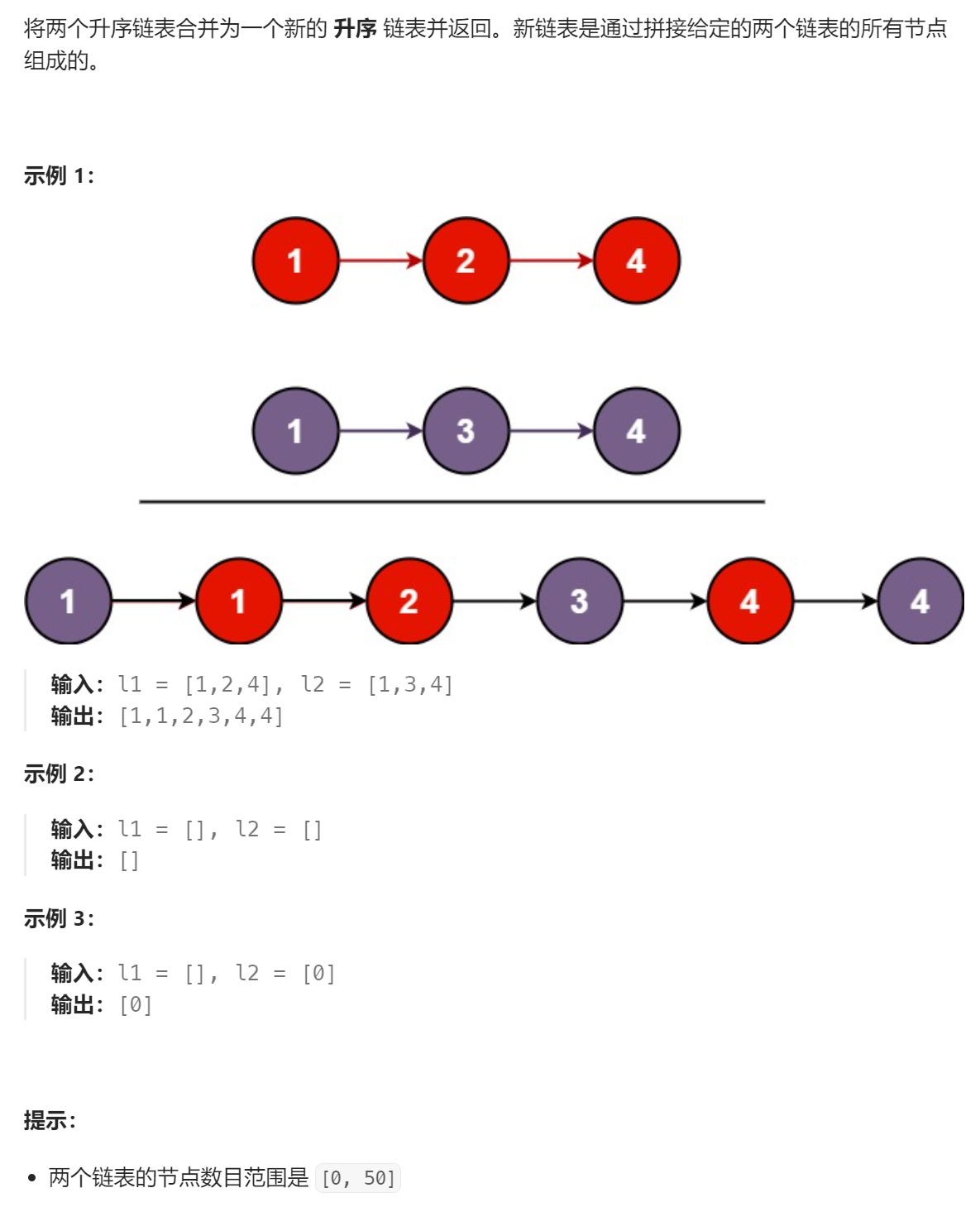
创建一个新的链表
- 两个指针分别指向两个链表
- 将两指针所指向的元素的较小值连接到新链表的尾
- 若有一个指针走到空,则将另一个指针连接到新链表的尾
struct ListNode* mergeTwoLists(struct ListNode* list1, struct ListNode* list2) {//定义新链表的头struct ListNode* newhead = (struct ListNode*)malloc(sizeof(struct ListNode));newhead->val = -1;newhead->next = NULL;struct ListNode* tail = newhead;//比较链表元素while(list1 && list2){if(list1->val < list2->val){tail->next = list1;tail = tail->next;list1 = list1->next;}else{tail->next = list2;tail = tail->next;list2 = list2->next;}}//若有一个链表为空,则连接另一个if(list1){tail->next = list1;}else{tail->next = list2;}struct ListNode* ret = newhead->next;free(newhead);newhead = tail = NULL;return ret;
}
3.链表的中间节点
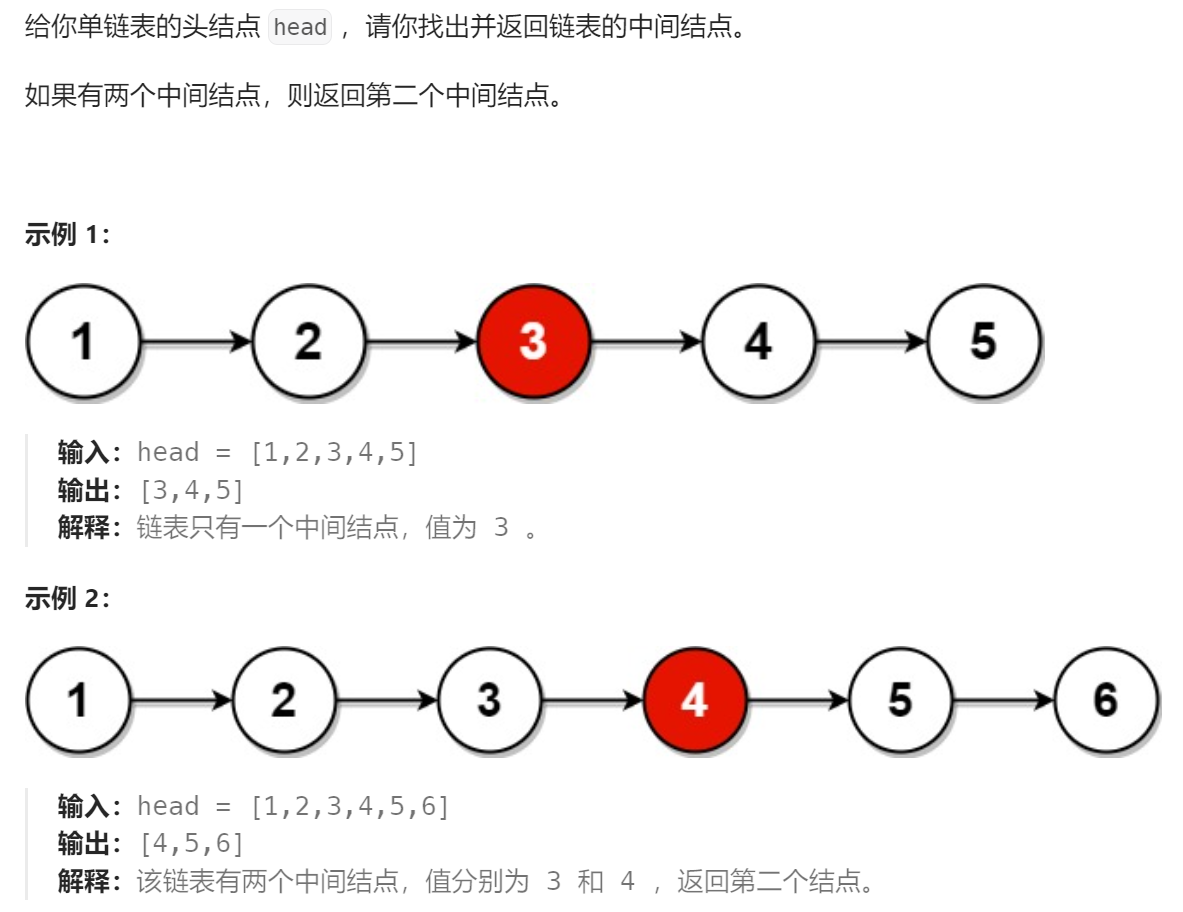
方法1
统计链表长度,计算出中间位置;再寻找中间位置
struct ListNode* middleNode(struct ListNode* head) {struct ListNode* cur = head;int len = 0;while(cur){len++;cur = cur->next;}int count = 0;cur = head;while(count < (len / 2)){count++;cur = cur->next;}return cur;
}
方法2
快慢指针法:一个指针一次走一步,一个指针一次走两步。当快指针尾空或者快指针的next为空,那么慢指针所指向的元素就是中间元素。
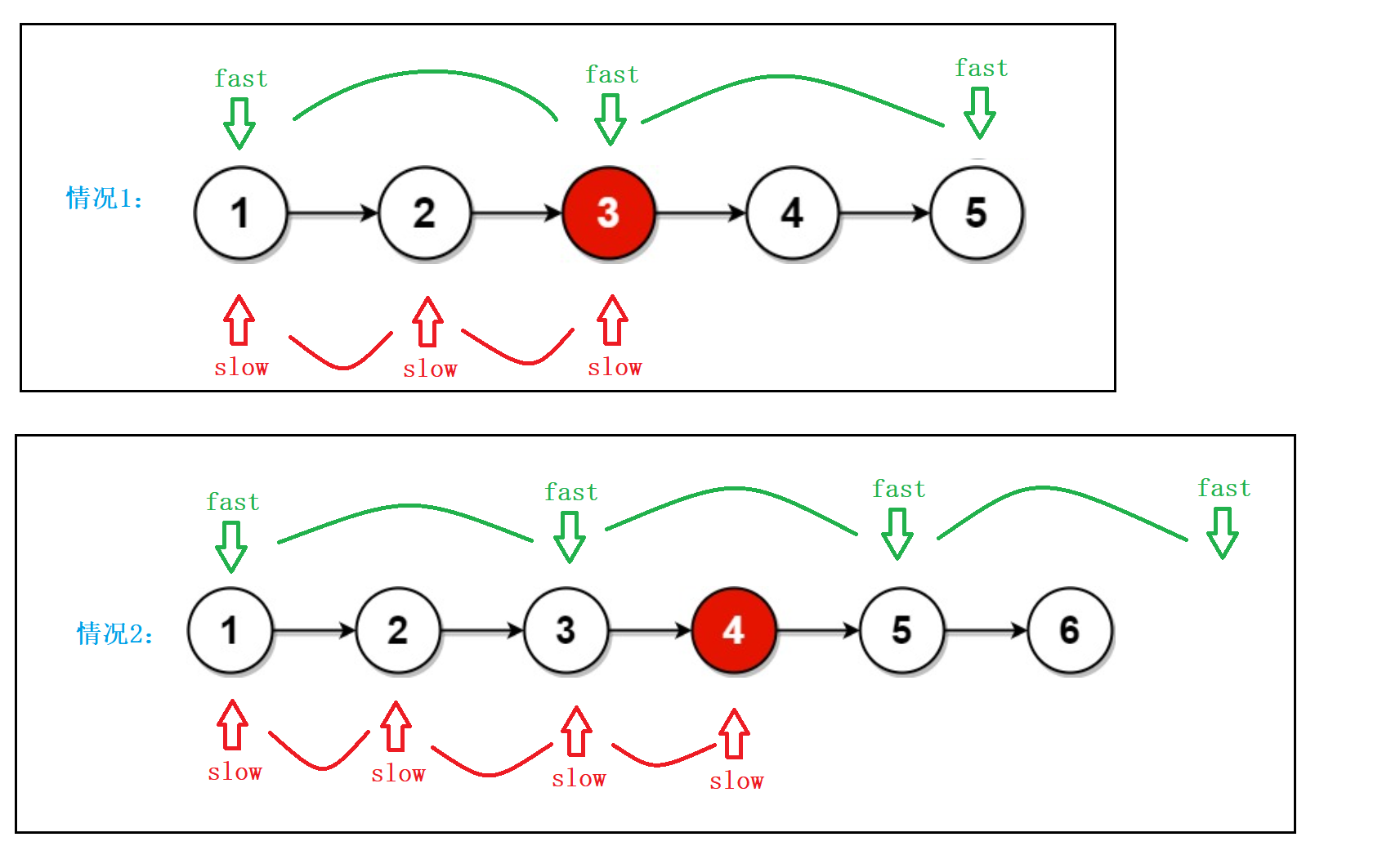
struct ListNode* middleNode(struct ListNode* head) {struct ListNode* slow = head;struct ListNode* fast = head;while(fast && fast->next){slow = slow->next;fast = fast->next->next;}return slow;
}
4.反转单链表

方法1
定义一个新的头节点,然后遍历链表,采取头插
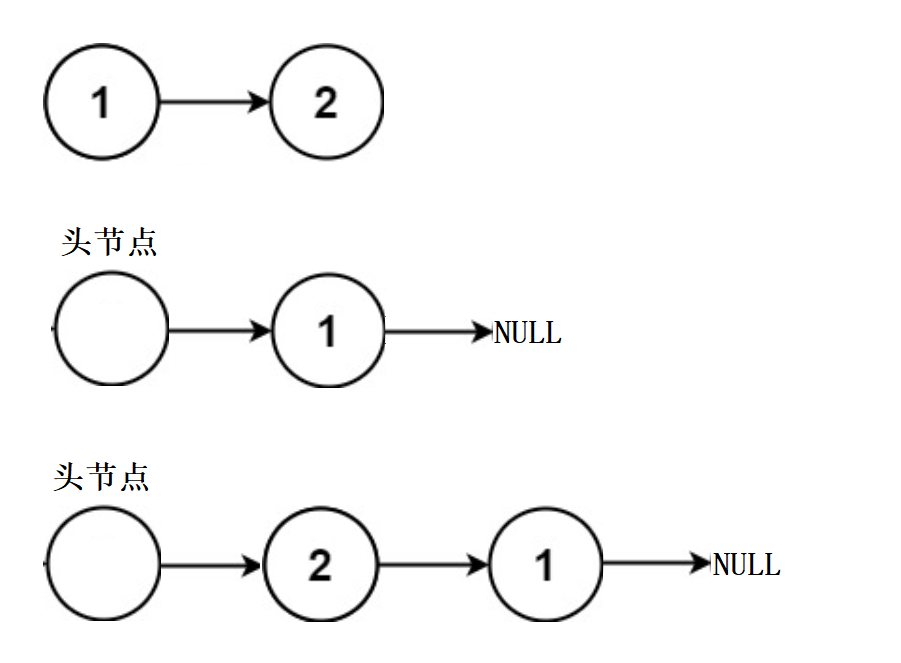
struct ListNode* reverseList(struct ListNode* head) {struct ListNode* newHead = (struct ListNode*)malloc(sizeof(struct ListNode));newHead->val = -1;newHead->next = NULL;while(head){//先记录后继节点struct ListNode* next = head->next;//头插head->next = newHead->next;newHead->next = head;//节点后移head = next;}return newHead->next;
}
方法2
原地直接反转
- 先记录当前节点的后继节点,以便节点后移
- 当前节点指向其前驱节点
- 前驱节点后移
- 当前节点后移
- prev即为反转后新的头
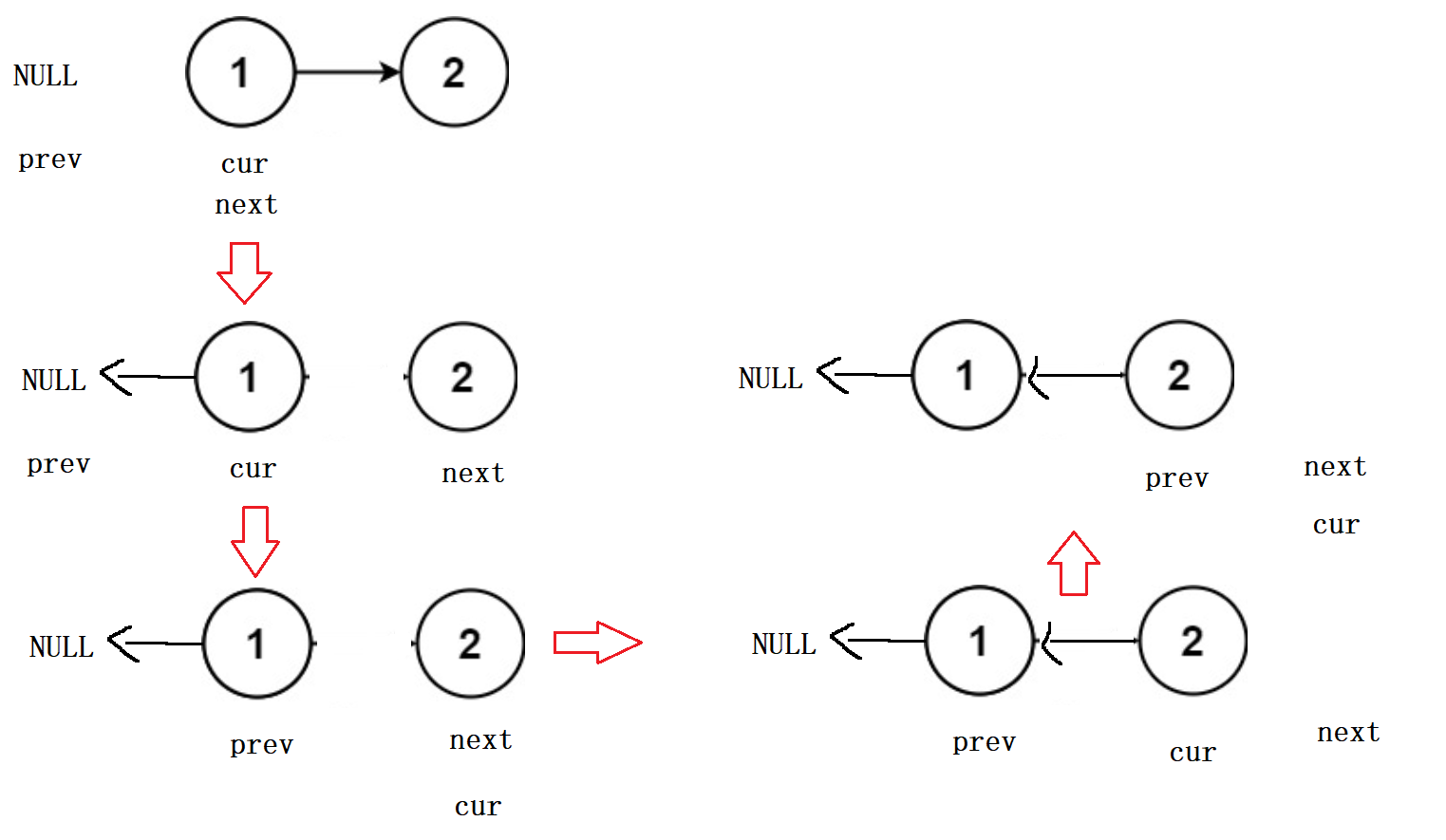
struct ListNode* reverseList(struct ListNode* head) {struct ListNode* next = NULL;struct ListNode* prev = NULL;struct ListNode* cur = head;while(cur){next = cur->next;cur->next = prev;prev = cur;cur = next;}return prev;
}
5.分割链表
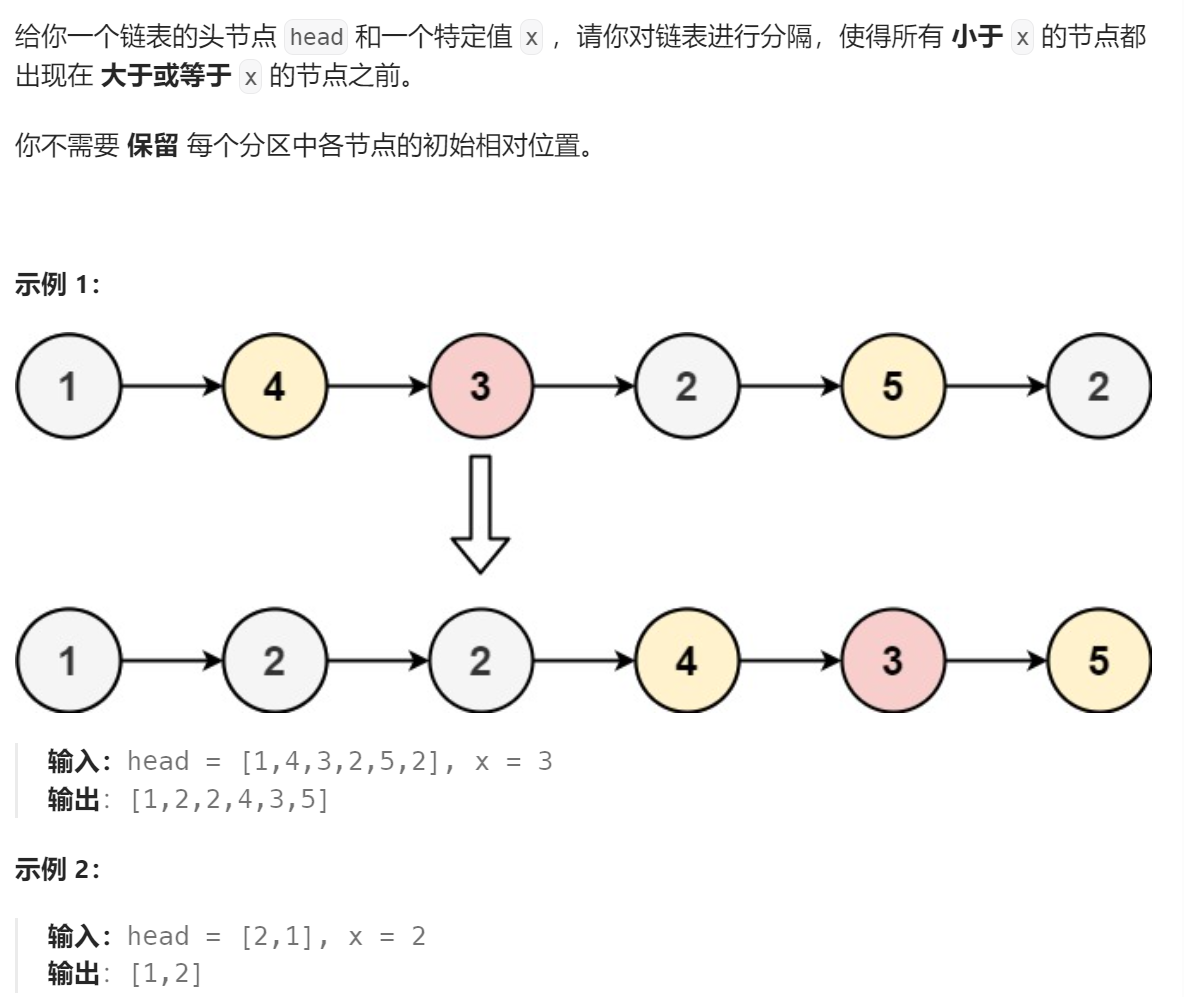
思路:
- 给定两个新的链表,一个放小于X的元素,一个放大于X的元素
- 元素尾插至新链表
- 将两个新链表相连

struct ListNode* partition(struct ListNode* head, int x){struct ListNode* minHead = (struct ListNode*)malloc(sizeof(struct ListNode));struct ListNode* maxHead = (struct ListNode*)malloc(sizeof(struct ListNode));struct ListNode* minTail = minHead;struct ListNode* maxTail = maxHead;struct ListNode* cur = head;while(cur){if(cur->val < x){minTail->next = cur;minTail = minTail->next;}else{maxTail->next = cur;maxTail = maxTail->next;}cur = cur->next;}//防止成环maxTail->next = NULL;minTail->next = maxHead->next;struct ListNode* ret = minHead->next;free(minHead);free(maxHead);return ret;
}
6.链表中的倒数第k个节点

方法1:
思路:倒数第k就是正数第n-k+1个(n为链表长度)
特殊情况:
- k应该小于链表长度
- k不能为0
- 链表不能为空
struct ListNode* FindKthToTail(struct ListNode* pListHead, int k) {struct ListNode* cur = pListHead;int len = 0;//求链表的长度while (cur){len++;cur = cur->next;}//特殊情况判断//1.k不能大于链表长度//2.k不能为0//3.链表不为空if (k > len || k == 0 || pListHead == NULL){return NULL;}//倒数第k个就是正数第n-k+1个int n = 1;len = len - k + 1;cur = pListHead;while (n != len){n++;cur = cur->next;}return cur;
}
方法2:
快慢指针:快指针先走k步,然后快慢一起走

struct ListNode* FindKthToTail(struct ListNode* pListHead, int k ) {struct ListNode* fast = pListHead;struct ListNode* slow = pListHead;//快指针先走k步while(k--){//fast不能走出链表(k符合)if(fast){fast = fast->next;}else {return NULL;}}while(fast){slow = slow->next;fast = fast->next;}return slow;
}
7.环形链表的约瑟夫问题

解题思路:
- 构建环形链表,给每个节点编号
- 逢m就删除节点,再从新报数
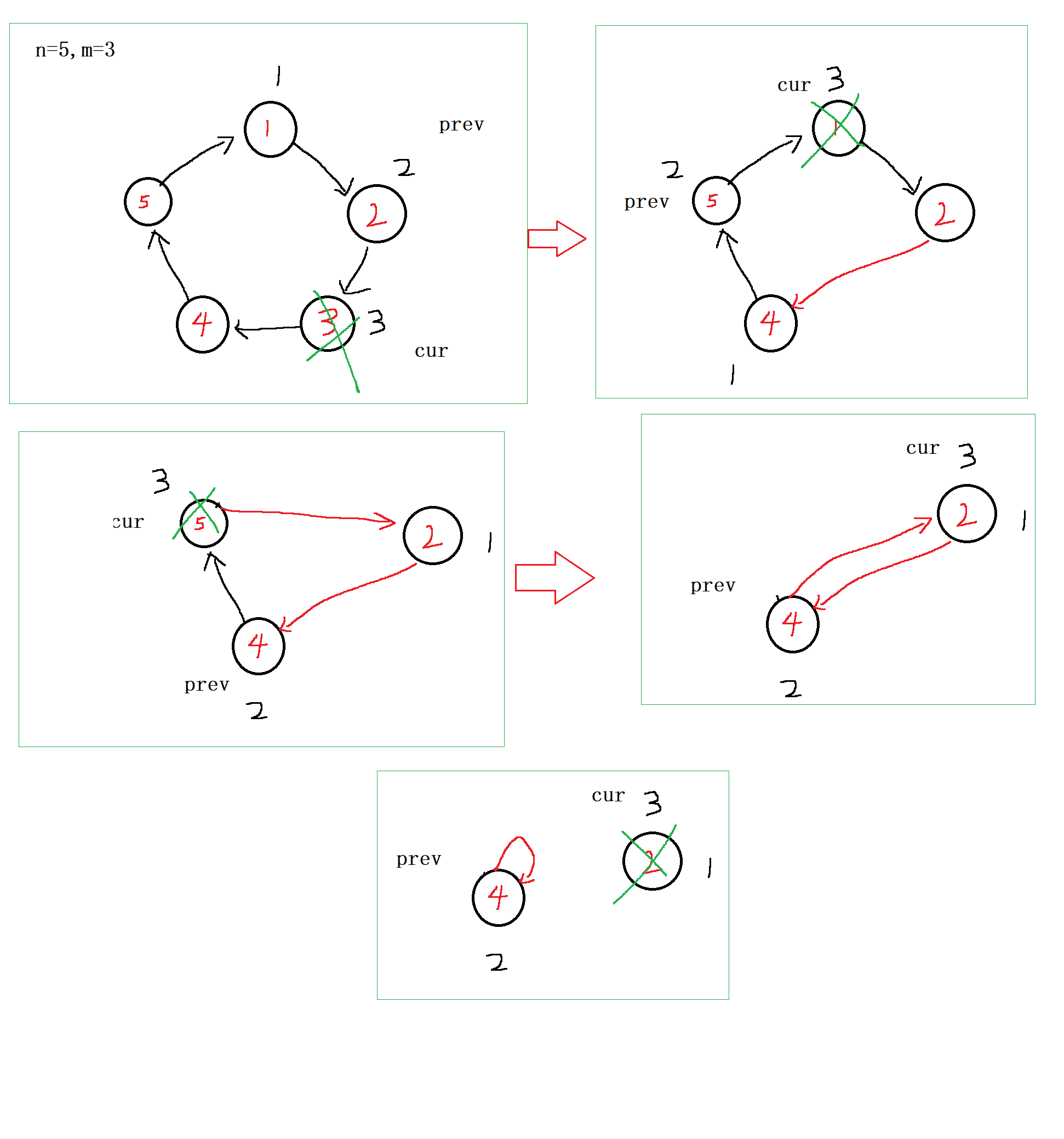
typedef struct ListNode ListNode;//创建节点
ListNode* CreatNode(int x)
{ListNode* newnode = (ListNode*)malloc(sizeof(ListNode));newnode->val = x;newnode->next = NULL;return newnode;
}//构建环
ListNode* CreatCircle(int n)
{ListNode* head = CreatNode(1);ListNode* tail = head;//连续创建节点for(int i=2; i<=n; i++){ListNode* newnode = CreatNode(i);//连接节点tail->next = newnode;tail = tail->next;}//成环tail->next = head;//返回尾节点的目的是:防止第一个元素就是要删除的元素return tail;
}int ysf(int n, int m ) {ListNode* prev = CreatCircle(n);ListNode* cur = prev->next;int count = 1;//有多个节点继续报数,直到剩下一个节点while(cur->next != cur){//逢m就删除if(count == m){prev->next = cur->next;free(cur);cur = prev->next;count = 1;}else {prev = cur;cur = cur->next;count++;}}return cur->val;
}
8.链表的回文结构
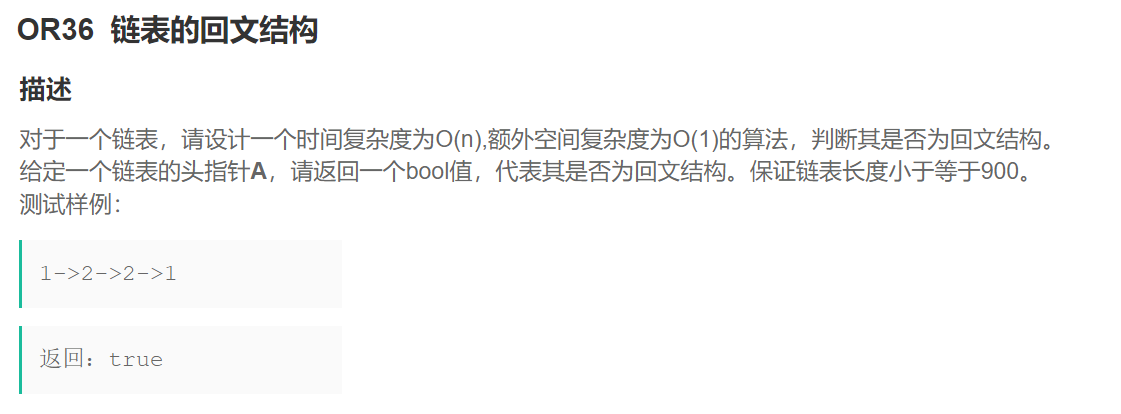
思路:从链表的中间节点逆置后半段,然后比较前半段与后半段是否相等。
- 快慢指针找链表的中间节点
- 从中间节点反转单链表
- 节点比较
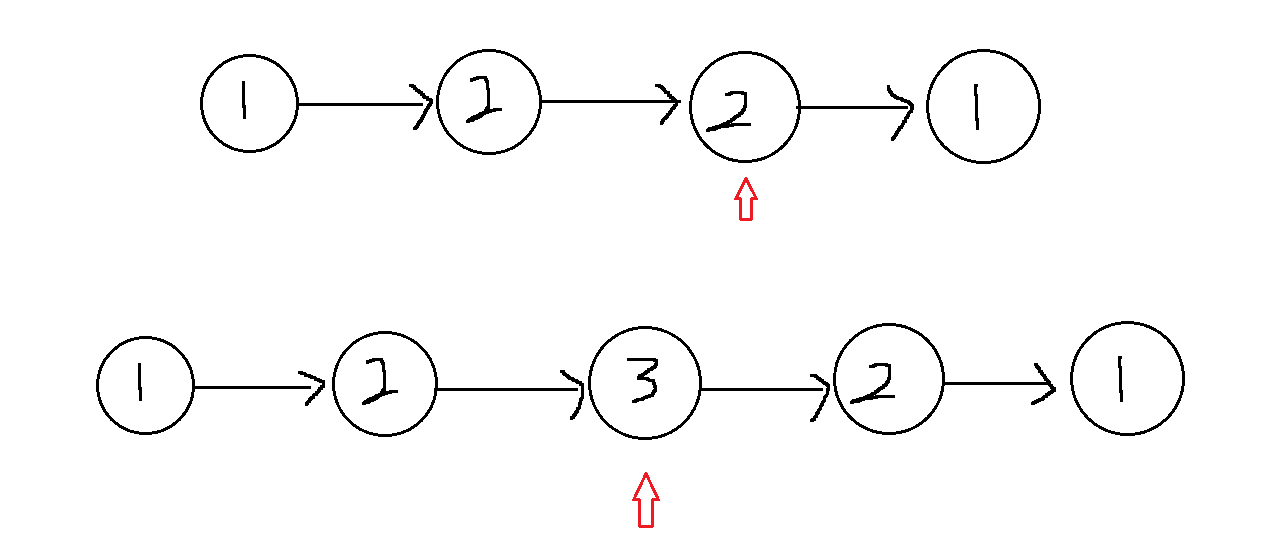
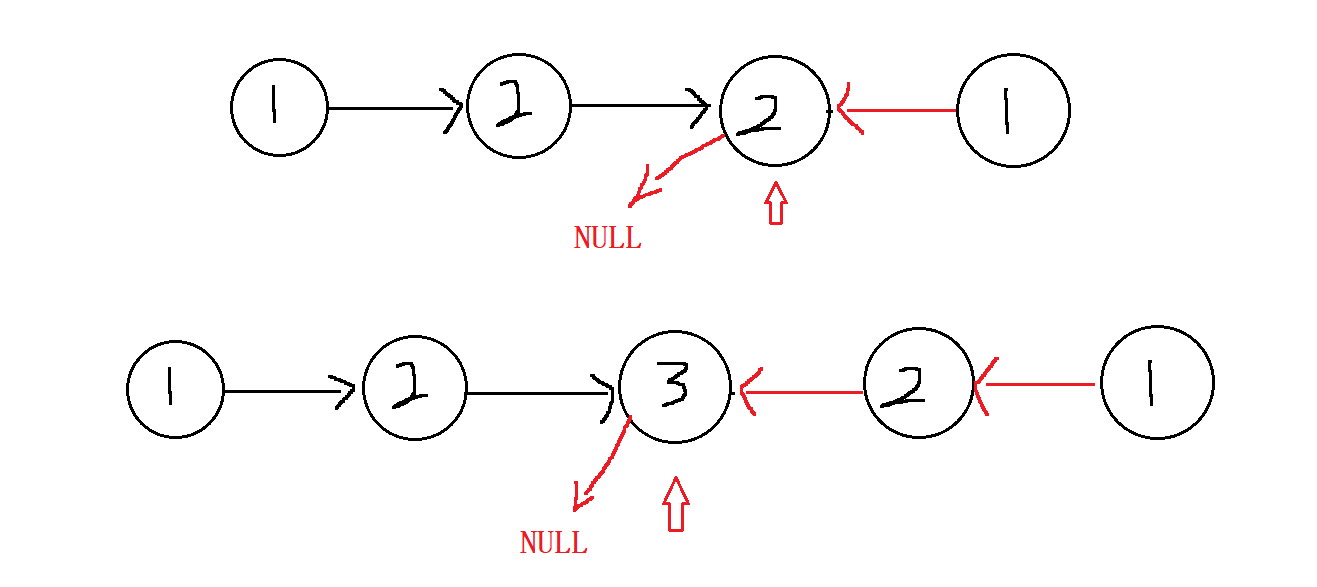
//找中间节点ListNode* FindMid(ListNode* A){ListNode* fast = A;ListNode* slow = A;while(fast && fast->next){fast = fast->next->next;slow = slow->next;}return slow; }//反转ListNode* Reverse(ListNode* mid){ListNode* cur = mid;ListNode* prev = NULL;ListNode* next = NULL;while(cur){next = cur->next;cur->next = prev;prev = cur;cur = next;}return prev;}bool chkPalindrome(ListNode* A) {ListNode* mid = FindMid(A);ListNode* midhead = Reverse(mid);while(midhead){if(A->val == midhead->val){A = A->next;midhead = midhead->next;}else {return false;}}return true;}
9.相交链表
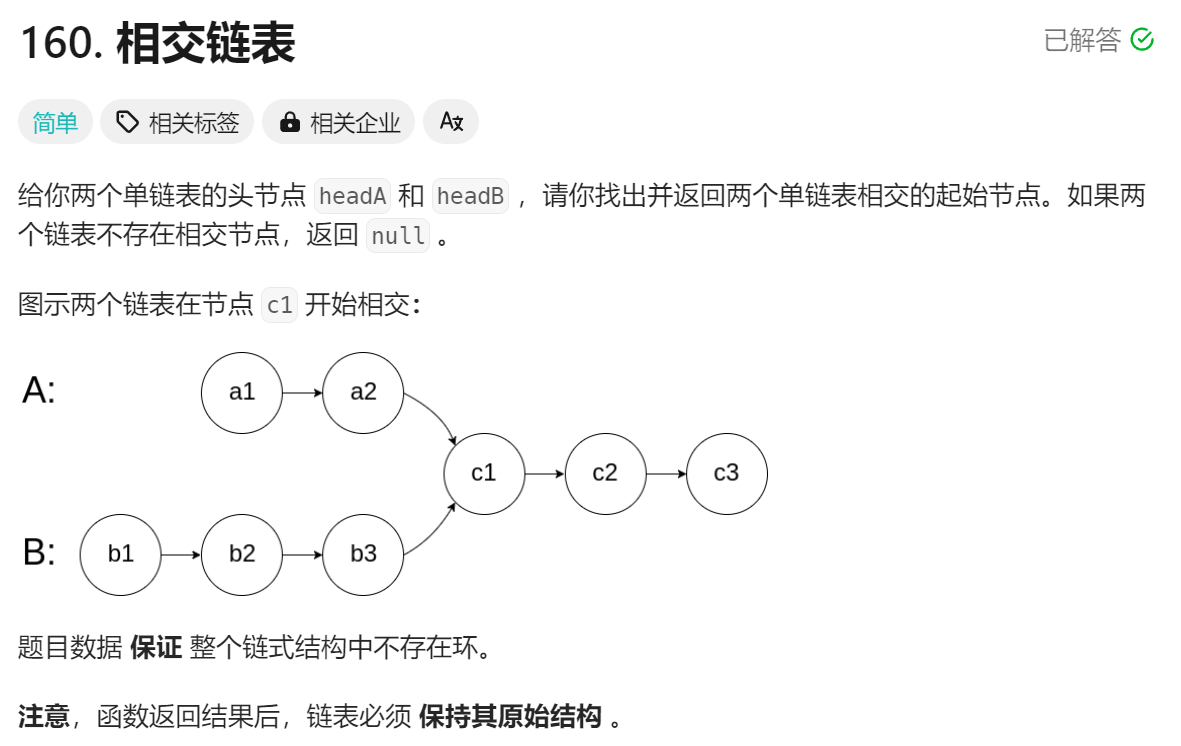
方法1
将链表A中的每一个节点与链表B中的每一个节点比较,看是否相等。
- 若相等,则返回相等的节点
- 若所有节点都不相等,则链表不相交。
struct ListNode *getIntersectionNode(struct ListNode *headA, struct ListNode *headB) {struct ListNode* curA = headA;struct ListNode* curB = headB;while(curA){curB = headB;while(curB){//若节点相等,直接返回相等节点if(curA == curB){return curA;}curB = curB->next;}curA = curA->next;}//A中每一个节点都与B比较完毕,仍无交点return NULL;
}
方法2:
分别计算两链表长度,长的先走长度差步,然后再一起走,判断是否相等。
- 再求链表长度的同时,若两链表的最后一个节点相等,则二者一定相交
struct ListNode* getIntersectionNode(struct ListNode *headA, struct ListNode *headB) {struct ListNode* curA = headA;struct ListNode* curB = headB;int lenA = 0;int lenB = 0;//先计算链表各自的长度,都少计算一个while(curA->next){lenA++;curA = curA->next;}while(curB->next){lenB++;curB = curB->next;}//若不相交,直接返回空if(curA != curB){return NULL;}//算长度差int gap = abs(lenA - lenB);struct ListNode* longList = headA;struct ListNode* shortList = headB;if(lenA < lenB){longList = headB;shortList = headA;}//长的先走长度差步while(gap--){longList = longList->next;}//同时走,找交点while(longList && shortList){if(longList == shortList){return shortList;}longList = longList->next;shortList = shortList->next;}return NULL;
}
10.环形链表
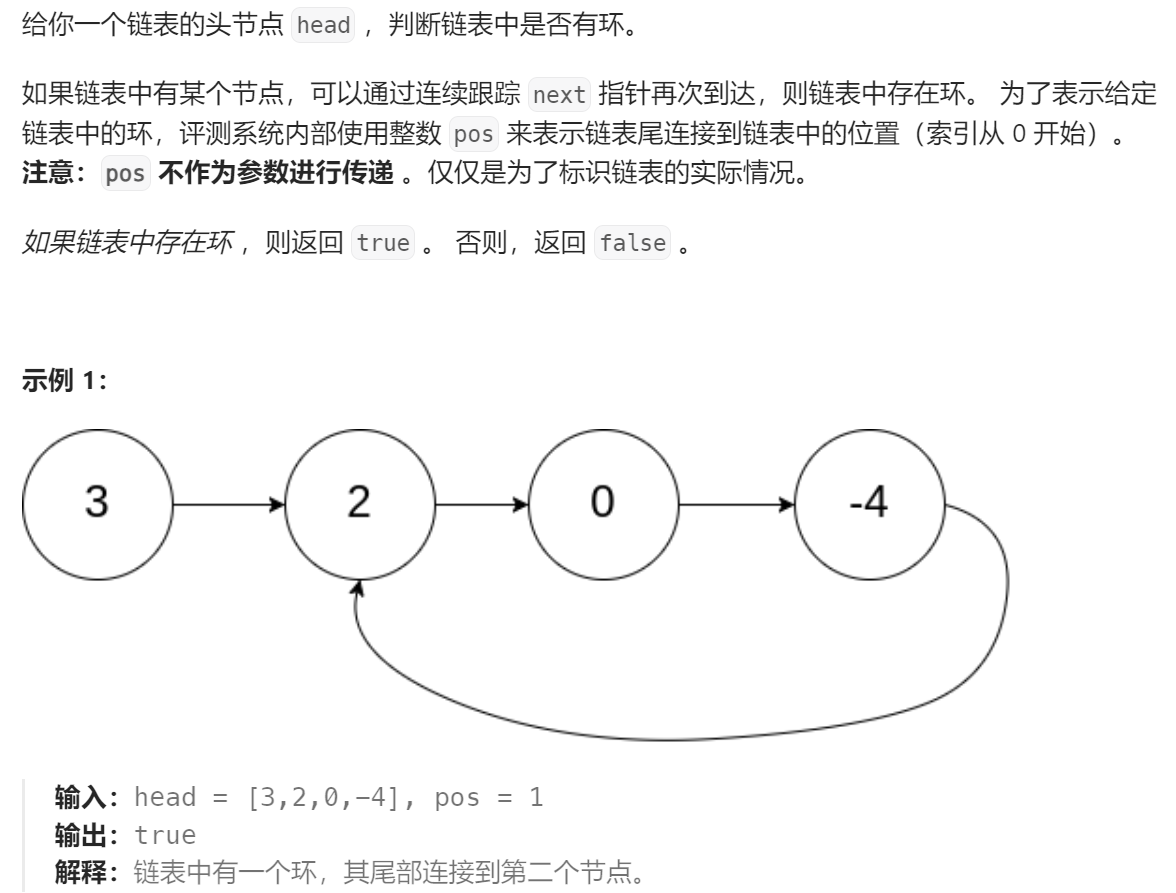
思路:快慢指针。
- 一个指针一次走一步,一个指针一次走两步
- 若快指针走到了空,则不带环
- 若快指针与慢指针相遇,则带环
bool hasCycle(struct ListNode *head) {struct ListNode * fast = head;struct ListNode * slow = head;while(fast && fast->next){slow = slow->next;fast = fast->next->next;if(slow == fast){return true;}}return false;
}
为什么这样可以呢?
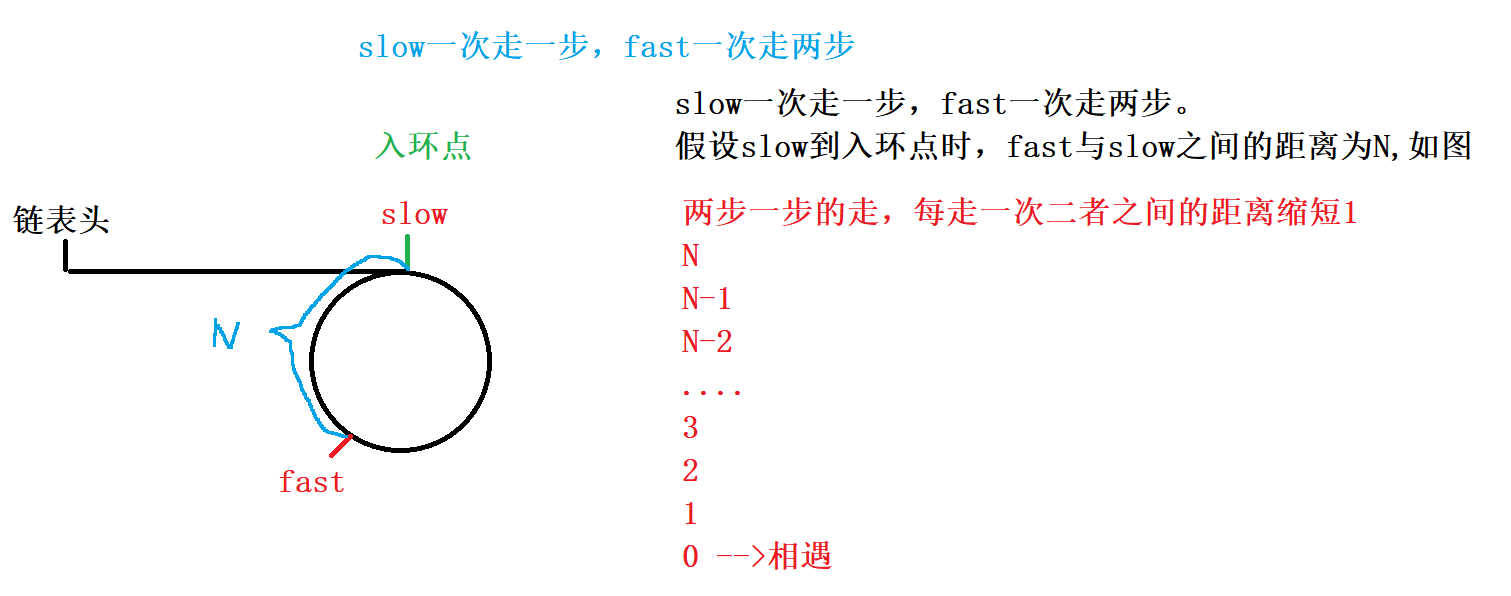
为什么不是一个走1步一个走3步?一个走1步一个走4步?一个走1步一个走6步?…
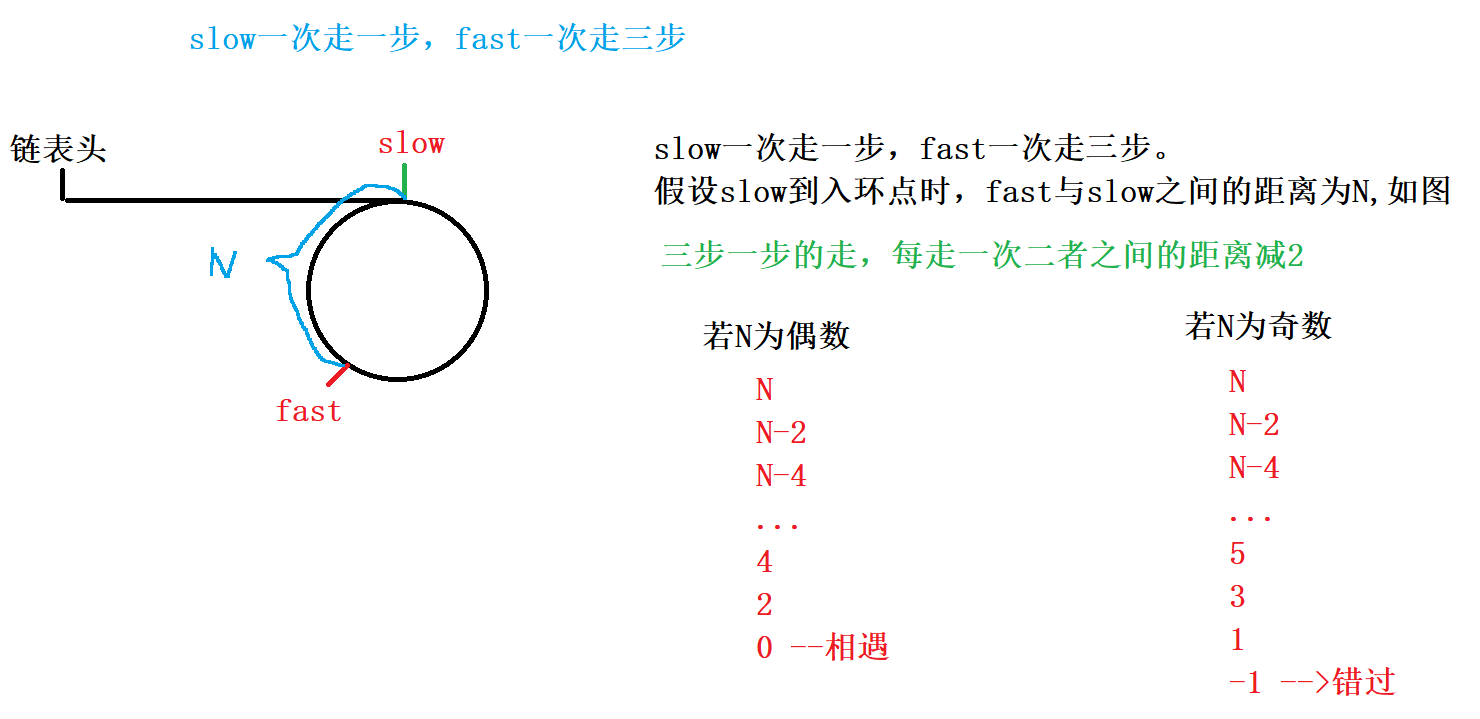
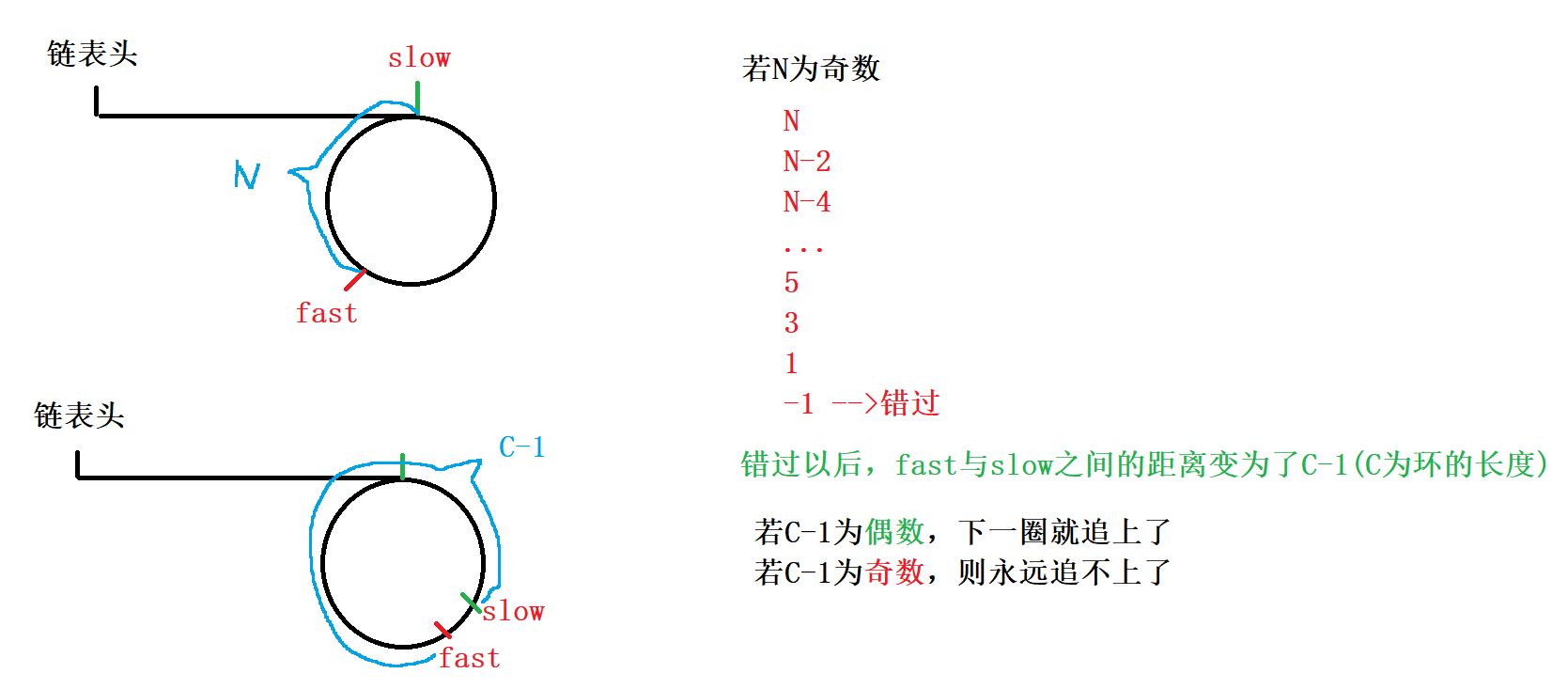
若N为奇数,C-1也为奇数则永远追不上(存在这种情况吗?)
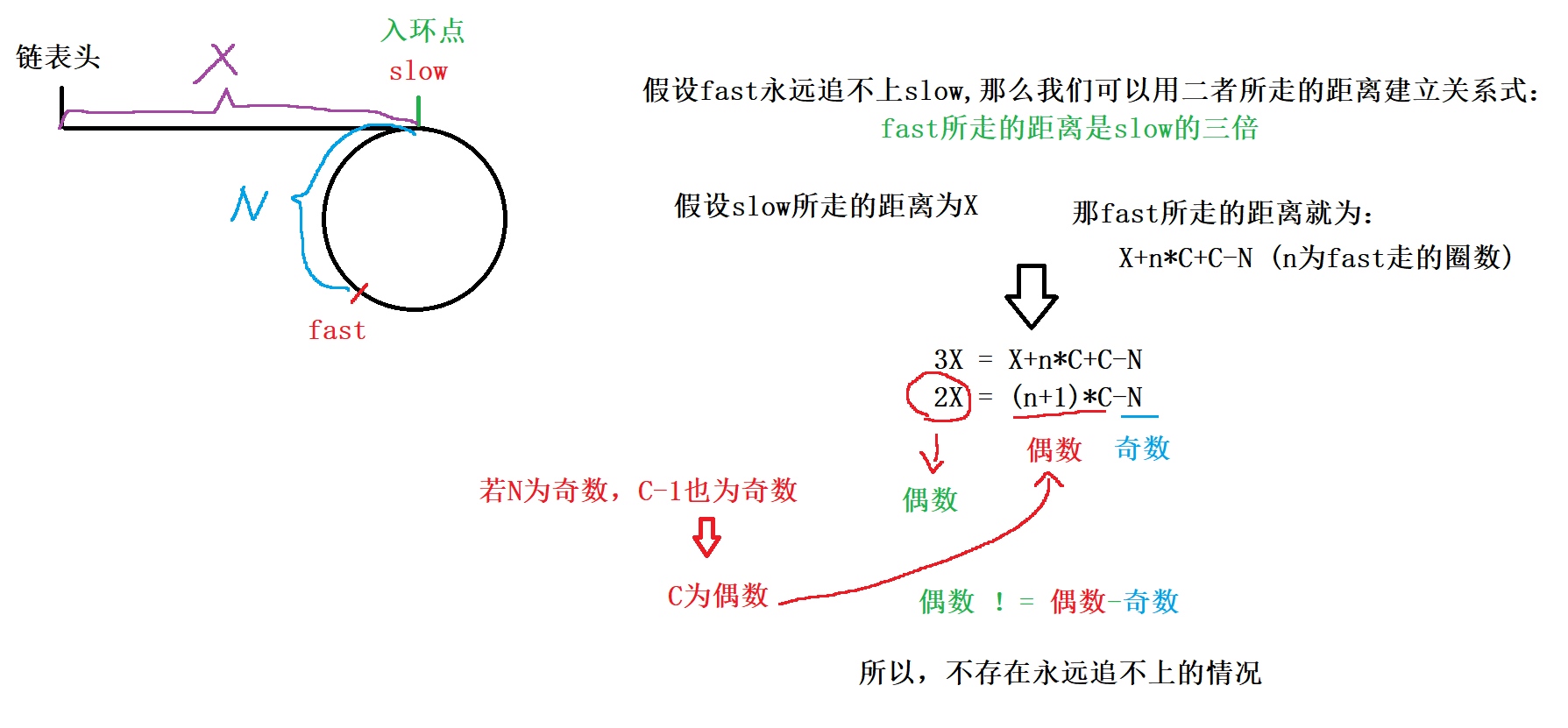
所以,一步两步走是最保险也是最简单的方式,不会错过。
11.环形链表Ⅱ

思路:快慢指针,找到二者的相遇点。再使用两指针,从相遇点和链表头开始走,二者相遇点就是入环点
struct ListNode *detectCycle(struct ListNode *head) {struct ListNode* slow = head;struct ListNode* fast = head;while(fast && fast->next){slow = slow->next;fast = fast->next->next;if(slow == fast){struct ListNode* meet = slow;while(meet != head){meet = meet->next;head = head->next;}return meet;}}return NULL;
}
原理

12.随机链表的复制

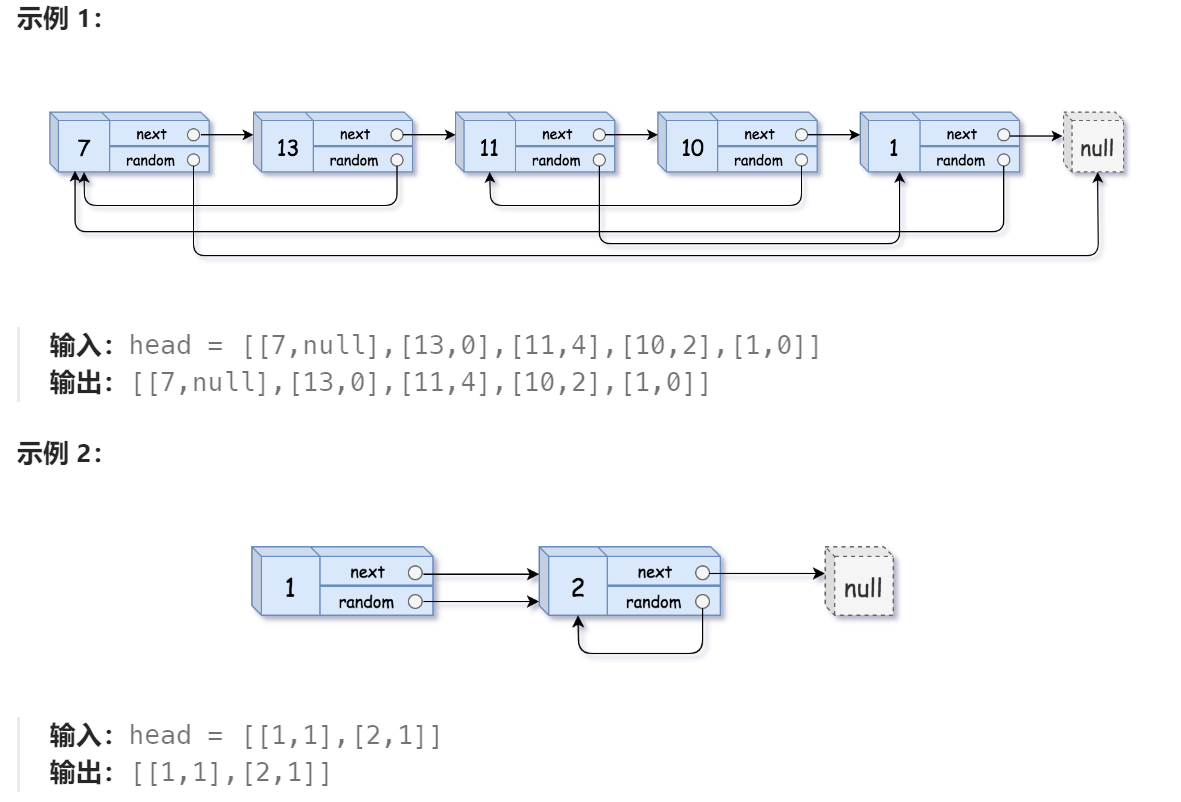
本题的难点在于random的指向难以找到
思路:
- 在原链表每个节点的后面尾插一个新的节点
- 根据原链表,找到新链表的random指向
- 将新链表的节点与原链表分离,恢复原链表
第一步:连接新节点

第二步:搞清random指向
新链表random就是原链表random的next!!!
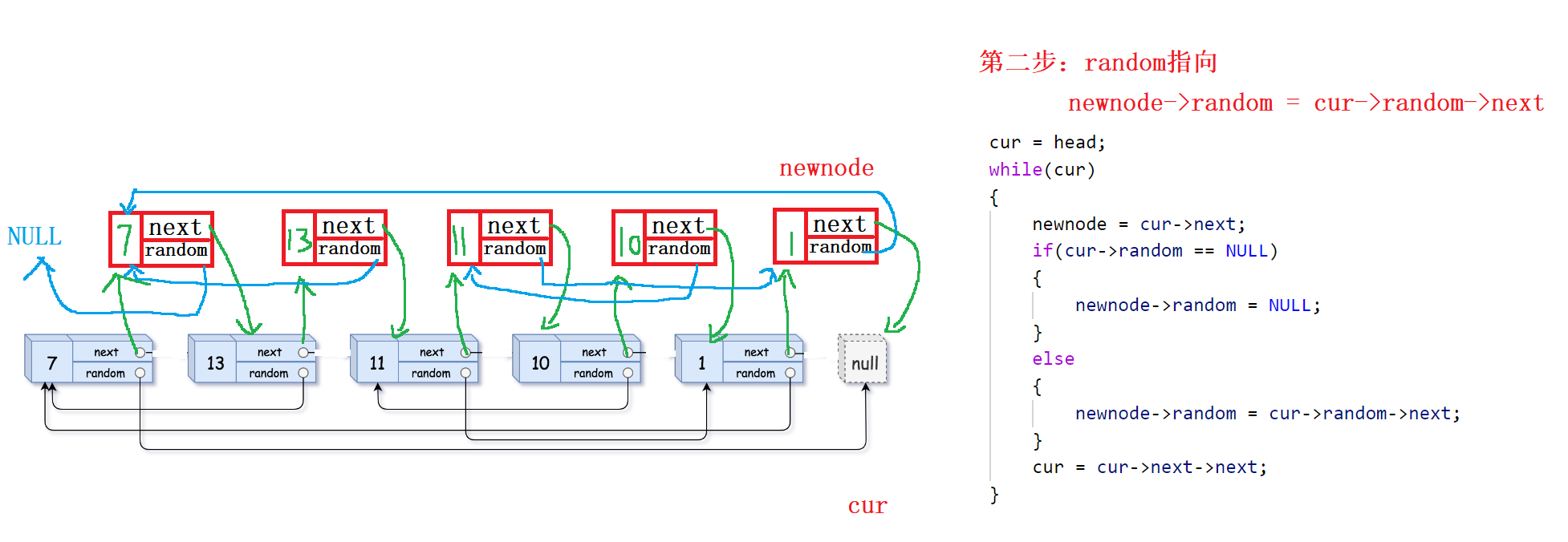
第三步:将新链表从原链表上摘下来

struct Node* copyRandomList(struct Node* head) {struct Node* cur = head;//插入新节点while(cur){struct Node* newnode = (struct Node*)malloc(sizeof(struct Node));//连接新节点newnode->val = cur->val;newnode->next = cur->next;cur->next = newnode;//原链表后移cur = cur->next->next;}//randomcur = head;while(cur){struct Node* newnode = cur->next;if(cur->random == NULL){newnode->random = NULL;}else{newnode->random = cur->random->next;}cur = cur->next->next;}//摘新链表struct Node* newhead = (struct Node*)malloc(sizeof(struct Node));newhead->next = NULL;newhead->random = NULL;struct Node* tail = newhead;cur = head;while(cur){//尾插新链表struct Node* newnode = cur->next;tail->next = newnode;tail = tail->next;//恢复原链表cur->next = newnode->next;cur = cur->next;}return newhead->next;
}


![第三节课[LangChain]作业](http://pic.xiahunao.cn/第三节课[LangChain]作业)

)



之间自动插入空格)

——篮球赛24秒违例倒计时报警器的proteus仿真)








)